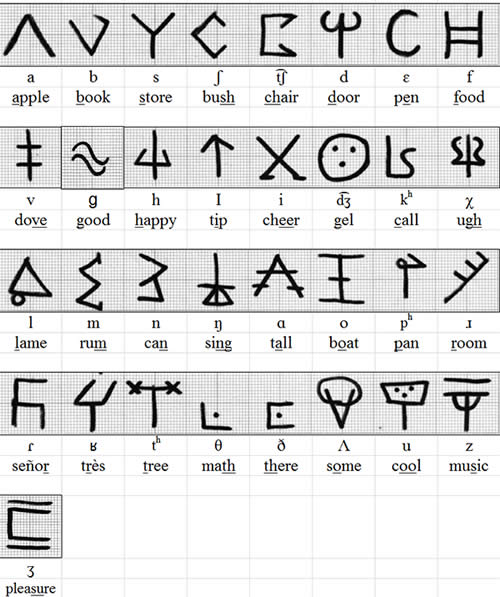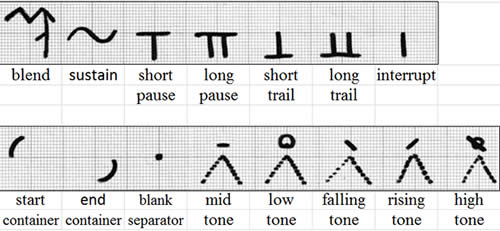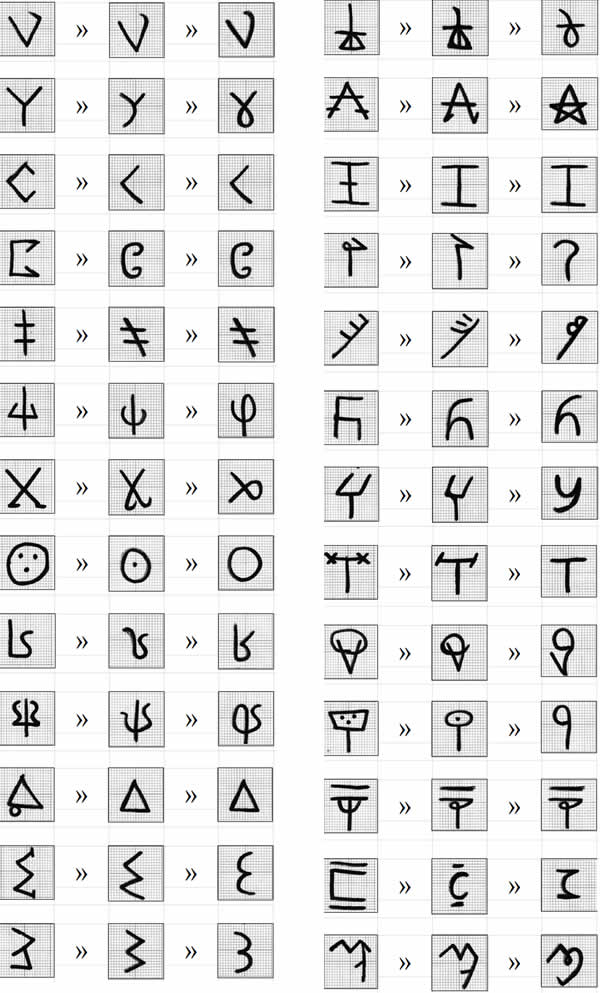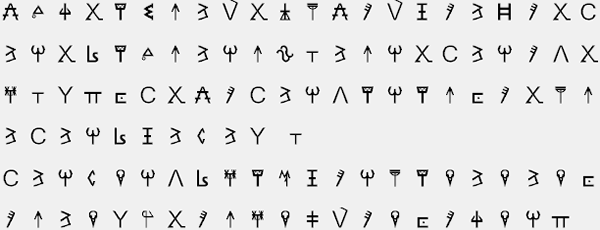Phineon alphabet

The Phineon alphabet was invented by Sabian Finogwar in November 2013,
and was revised in December 2015. Phineon can be used to write any language
which uses only pulmonic consonants, such as English, Japanese, and Chinese;
but has no characters for certain Middle Eastern character sounds.
Notable features
- Type of script: alphabet
- Direction of writing: left to right in horizontal lines
- Used to write: any non-tonal language that contains only pulmonic sounds
Phineon alphabet
Standard characters

Diacritics and special characters

Notes
- The blend character is used to gradient together two sounds (e.g. the 'tw' in "twig", and the 'pr' in "prime"), but for consecutive consonants or vowels, is generally implied and unneeded.
- However, it is also used to fade in a vowel sound, as opposed to suddenly pronouncing it.
(e.g. "ear" vs "year", and "uber" vs "war")
- The sustain character is used for enunciation and or elongation of syllables and vowel sounds.
- For example, the proper English pronunciation of "Bible" would be written with a sustain character directly after the first syllable, as that is the syllable which is enunciated.
- Another example would be "Canoe"; the sustain character would be after the second syllable.
- A third example is enunciating the word “please” in the sentence “Can you PLEASE stop talking?” by adding a sustain character directly after the vowel character in “please”.
- The short pause character defines approximately a one second pause, in speech. Generally, this is used to signify commas and ends of sentences, but serves no grammatical purpose.
- The long pause character defines approximately a two, or more, second pause, in speech, and generally is used to pause for dramatic effect.
- The short trail character signifies a fading to silence, or trailing off, in speech, and takes approximately half a second, to fade.
- The long trail character signifies a fading to silence, taking approximately one to two seconds, to fade.
- The interrupt character defines a halt in speech, wherever it is placed. In English, most consonant sounds halt, when they are placed at the end of a word.
- One example would be the pronunciation of “t”. As opposed to its pronunciation in “tank”, at the end of the word “cat”, the breathy pronunciation of “t” is halted.
- Another example would be the preference-differing pronunciation of “made”. Some are partial to halting the “d”, some to pronouncing the full “d” sound; it also differs based on accent.
- The start and end characters are generally used as opening and closing parentheses or quotation marks (characters used to contain things; containers).
- The blank character is used to separate characters from the other special characters. For example, to halt, after pronouncing a full consonant (e.g. “made”) — as in halting after pronouncing the full sound—to signify a stoppage of breathing, this character would be inserted just before the halt character.
- One example would be the terminating sounds of Japanese. Terminating sounds in Japanese tend to halt the breath, after pronouncing the sounds (e.g. “natsu” / 「なつ」 / 「夏」)
- The tone diacritics are placed over vowels and consonants. When placed over vowels, the tone applies to the syllable, and is compounded with any tones placed on consonants, to affect the overall tone progression of words and entire sentences. What this means is the tone diacritics can be used for non-tonal languages, such as English, which have specific question tones, for whole sentences.
- One crucial detail to remember is the tone diacritics can stack above or below the mid tone diacritic. When stacked above, the tones are offset high, and when stacked below, are offset low. These combinations can be used to represent very high or very low tones.
- For example, when a low tone is placed below a mid tone, it becomes a very low tone, and when a high tone is placed above a mid tone, it becomes a very high tone. Again, these are not restricted to tonal languages, and can apply to any language, for dramatic effect.
Character evolution
Over time Sabian made alterations to the characters to simulate a natural progression of writing, and to evolve the script into something more modern. He took into consideration the efficiency of the writing, and the ease of flowing from one character, to the next, in a more modern world, to accommodate the writing styles beyond the times of chiselling into stone. While there are two to three different ways of writing the characters, all forms are accepted, and like English fonts, are based on preference, so choose one style of each character, and stick to it, for it will become yours.

Sample text

Translation
All human beings are born free and equal in dignity and rights. They
are endowed with reason and conscience and should act towards one another
in a spirit of brotherhood.
(Article 1 of the Universal Declaration of Human Rights)
Constructed scripts for: Ainu |
Arabic |
Chinese languages |
Dutch |
English |
Hawaiian |
Hungarian |
Japanese |
Korean |
Lingala |
Malay & Indonesian |
Persian |
Tagalog / Filipino |
Russian |
Sanskrit |
Spanish |
Taino |
Turkish |
Vietnamese |
Welsh |
Other natural languages |
Colour-based scripts |
Tactile scripts |
Phonetic/universal scripts |
Constructed scripts for constructed languages |
Adaptations of existing alphabets |
Fictional alphabets |
Magical alphabets |
A-Z index |
How to submit a constructed script
[top]

You can support this site by Buying Me A Coffee, and if you like what you see on this page, you can use the buttons below to share it with people you know.

If you like this site and find it useful, you can support it by making a donation via PayPal or Patreon, or by contributing in other ways. Omniglot is how I make my living.
Note: all links on this site to Amazon.com , Amazon.co.uk
, Amazon.co.uk and Amazon.fr
and Amazon.fr are affiliate links. This means I earn a commission if you click on any of them and buy something. So by clicking on these links you can help to support this site.
are affiliate links. This means I earn a commission if you click on any of them and buy something. So by clicking on these links you can help to support this site.
[top]





, Amazon.co.uk
and Amazon.fr
are affiliate links. This means I earn a commission if you click on any of them and buy something. So by clicking on these links you can help to support this site.